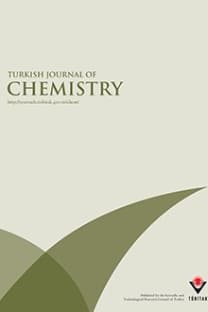Ultrarapid catalytic reduction of some dyes by reusable novel erythromycin-derived silver nanoparticles
Inorganic compounds, chemical synthesis, X-ray diffraction, catalytic properties
Ultrarapid catalytic reduction of some dyes by reusable novel erythromycin-derived silver nanoparticles
___
- Sondi, I.; Goia, D. V.; Matijevic, E. J. Colloid Interface Sci. 2003, 260, 75–81.
- Edison, T. I.; Sethuraman, M. G. Process. Biochem. 2012, 47, 1351–1357.
- Aksomaityte, G.; Poliakoff, M.; Lester, E. Chem. Eng. Sci. 2013, 85, 2–10.
- Darroudi, M.; Zak, A. K.; Muhamad, M. R.; Huang, N. M.; Hakim, M. Mater. Lett. 2012, 117, 117–120.
- Kim, S. E.; Park, J. H.; Lee, B.; Lee, J. C.; Kwon, Y. K. Radiat. Phys. Chem. 2012, 81, 978–981.
- Balamurugan, A., Ho, K. C.; Chen, S. M. Synth. Met. 2009, 159, 2544–2549.
- Tagar, Z. A.; Sirajuddin, Memon, N.; Agheem M. H.; Junejo, Y.; Hassan, S. S.; Kalwar, N. H.; Khattak, M. I. Sens. Actuators B 2011, 157, 430-37.
- Junejo, Y.; Karao˘glu, E.; Baykal, A.; Sirajuddin J. Inorg. Organomet. Polym. 2013, 23, 970–975.
- Kouvaris, P.; Delimitis, A.; Zaspalis, V.; Papadopoulos, D.; Tsipas, S. A.; Michailidis, N. Mater. Lett. 2012, 76, 18–
- Jagtap, U. B.; Bapat, V. A. Ind. Crops Prod. 2013, 46, 132–137.
- Bar, H.; Bhui, D. K.; Sahoo, G. P.; Sarkar, P.; Pyne, S.; Misra, A. Colloids Surf. A: Physicochem. Eng. Aspects 2009, 348, 212–216.
- Saha, S.; Wang, J. M.; Pal, A. Sep. Purif. Technol. 2012, 89, 147–159.
- Nanda, A.; Saravanan, M. Nanomedicine: Nanotechnology Biology and Medicine 2009, 5, 452–456.
- Cho, K. H.; Park, J. E.; Osaka, T.; Park, S. G. Electrochim. Acta 2005, 51, 956–960.
- Sondi, I.; Sondi, B. S. J. Colloid Interface Sci. 2004, 275, 177–182.
- Shahverdi, A. R.; Fakhimi, A.; Shahverdi, H. R.; Minaian, S. Nanomedicine: Nanotechnology Biology and Medicine 2007, 3, 168–171.
- Maneerung, T.; Tokur,a S.; Rujiravanit, R. Carbohydr. Polym. 2008, 72, 43–51.
- Pradhan, N.; Pal, A.; Pal, T. Langmuir 2001, 17, 1800–1802.
- Burda, C.; Chen, X.; Narayanan, R.; El-Sayed, M. A. Chem. Rev. 2005, 105, 1025–1102.
- Siani, A.; Wigel, K. R.; Alexeev, O. S.; Amiridis, M. D. J. Catal. 2008, 257, 5–15.
- Cortie, M. B.; Van der Lingen, E. Mater. Forum 2002, 26, 1–14.
- Brown, M. A.; De Vito, S. C. Crit. Rev. Environ. Sci. Technol. 1993, 23, 249–324.
- Safarik, I.; Ptackova, L.; Safarikova, M. Eur. Cell Mater. 2002, 3, 52–55.
- Lin, J.; Zong, R.; Zhou, M.; Zhu, Y. Appl. Catal. B: Environ. 2009, 89, 425–431.
- Ibhadon, A. O.; Greenway, G. M.; Yue, Y. Catal. Commun. 2008, 9, 153–157.
- Lachheb, H.; Puzenat, E.; Houas, A.; Ksibi, M.; Elaloui, E.; Guillard, C.; Herrmann, J. M. Appl. Catal. B: Environ. 2002, 39, 75–90.
- Ferreira-Leitao, V. S.; da Silva, J. G.; Bon, E. P. S. Appl. Catal. B Environ. 2003, 42, 213–221.
- Daneshvar, N.; Aleboyeh, A.; Khataee, A. R. Chemosphere 2005, 59, 761–767.
- Jana, N. R.; Wang, Z. L.; Pal, T. Langmuir 2000, 16, 2457–2463.
- Fan, J.; Guo, Y.; Wang, J.; Fan, M. J. Hazard. Mater. 2009, 166, 904–910.
- Sau, T. K.; Pal, A.; Pal, T. J. Phys. Chem. B 2001, 105, 9266–9272.
- Martin, C. F.; Birot, M.; Deleuze, H.; Desforges, A.; Backov, R. React. Funct. Polym. 2007, 67, 1072–1082.
- Kumar, P.; Govindaraju, M.; Senthamilselvi, S.; Premkumar, K. Colloids Surf. B 2013, 103, 658–661.
- Kalwar, N. H.; Sirajuddin; Sherazi, S. H.; Khaskheli, A. R.; Hallam, K. R.; Scott, T. B.; Tagar, Z. A.; Hassan, S. S. Appl. Catal. A: Gen. 2013, 453, 54–59. 35. Peng, H.; Yang, A.; Xiong, J. Carbohydr. Polym. 2013, 91, 348–355.
- Philip, D.; Unni, C.; Aromal, S. A.; Vidhu, V. K. Spectrochim. Acta A 2011, 78, 899–904.
- Wejrzanowski, T.; Pielaszek, R.; Opalinska, A.; Matysiak, H.; Lojkowski, W.; Kurzydowski, K. J. Appl. Surf. Sci. 2006, 31, 253–264.
- ISSN: 1300-0527
- Yayın Aralığı: 6
- Yayıncı: TÜBİTAK
Yaşar DÜRÜST, Hamza KARAKUŞ, Muhsine Zeynep YAVUZ, Ali Akçahan GEPDİREMEN
Gülden Başmakçi AKYIL, Hayriye Eda Şatana KARA, Sezen Yarimkaya BAŞ, Nusret ERTAŞ, Nilgün GÜNDEN GÖĞER
Mohammad Shakhawoat HOSSAIN, Sıdıka POLAT ÇAKIR\dag, Ayşe Betül KARADUMAN
Performance degradation of LixFePO4 (x = 0, 1) induced by postannealing
Xiaofei SUN, Youlong XU, Xiaoyu ZHENG, Xiangfei MENG, Rui ZHANG
Green synthesis of Fe3O4 nanoparticles by one-pot saccharide-assisted hydrothermal method
Ayşe DEMİR, Abdulhadi BAYKAL, Hüseyin SÖZERİ
Calixcephems: clustered cephalosporins analogous to calixpenams as novel potential anti-MRSA agents
Fazel Nasuhi PUR, Karim Akbari DILMAGHANI
Binding of flavanone with b-CD/ctDNA: a spectroscopic investigation
Chandrasekaran SOWRIRAJAN, Sameena YOUSUF, Muthu Vijayan Enoch İsrael VIJAYARAJ
Graphite oxide as an efficient solid reagent for esterification reactions
Maryam MIRZA-AGHAYAN, Rabah BOUKHERROUB, Mahshid RAHIMIFARD
Study on transportation of phenol through a nanotubule membrane
